When you think about the best microphones for podcasting, the first thing that should come to mind is how well they perform for speech and voice. There are hundreds of different options when it comes to choosing a microphone, but not all mics are created equal.
Some microphones are perfect for singing because they were designed with a frequency response tailored for that specific purpose, and the results are fantastic. But when it comes to podcasting, the mic needs to be explicitly designed for the spoken word so that the voice sounds full, rich, and warm. That way, your audience can enjoy what you have to say in your podcast show.
In today’s article, we present the best microphones for podcasting. Some of the choices are condenser, while others are dynamic mics. All microphones included in this list will deliver the best results when it comes to the spoken word. Each one was carefully chosen, taking into consideration their frequency response, response curve, and polar pattern. This list is arranged from the lowest to the highest price.
Before we dive into the reviews of each mic, you need to understand something. If you are a solo podcaster, a USB mic will work perfectly for you because you would connect it straight to your computer and start recording.
But if you plan to have guests on your podcast, or run a podcast with more than one person, I highly recommend buying microphones with XLR connections. To connect it to the computer for recording, use an audio interface. This setup will make it easier and more versatile.
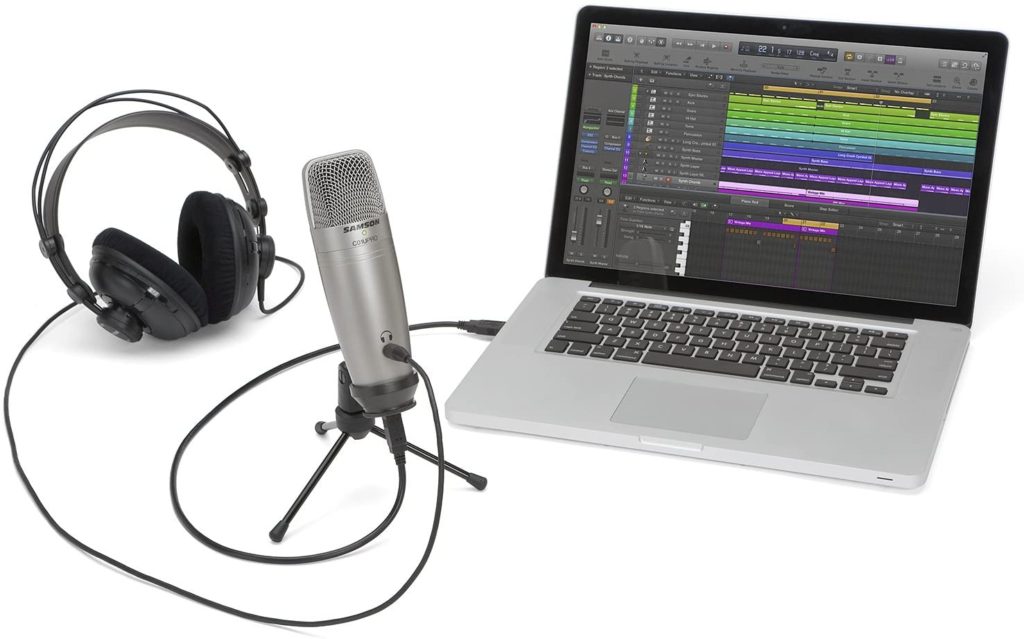
The 5 Best Microphones for Podcasting
- Samson C01U
- Rode NT-USB
- Rode Procaster
- Electro-Voice RE320
- Shure SM7B
Samson C01U Pro USB Studio Condenser Microphone

With the Samson C01U Pro, you get an affordable condenser mic that delivers high-quality audio. With this entry-level microphone, you don’t need an audio interface because it’s already built-in.
All you need to do is connect it to a PC or laptop and use your favorite Digital Audio Workstation software (DAW) to start recording your podcast. In case you don’t have a recording software, you can use Audacity, it is an entirely free DAW.
Sound Quality of the Samson C01U Pro
The sound quality of this condenser mic is characterized for its fullness and clarity. All of this is achieved thanks to the featured large, 19mm ultra-thin diaphragm capsule with a wide range frequency response that goes between 20Hz and 18kHz.
Furthermore, the response curve of the C01U shows a relatively flat response for the frequencies present in the human vocal range. There is a slight increase at higher frequencies.
Putting this in simpler terms, this mic delivers beautiful crisp highs, warm, clear mids, and well-defined lows, making it perfect for podcasting. The Samson C01U is one of the best affordable microphones for podcasting, costing less than $100.
Features
- Entry-level studio-quality condenser with USB Digital Output.
- The polar pattern is hyper-cardioid, perfect for podcasting.
- Maximum SPL is 136dB.
- Built-in headphone amp for monitoring.
- Compatible with Mac OS and Windows. This is a plug and play microphone, no driver installation needed.
- It is compatible with any computer-based Digital Audio Workstation.
- With the C01U, you’ll get extremely detailed sound reproduction, making it ideal for recording speech. It also works well for recording acoustic instruments and just about any other sound source.
- The built-in A/D converter delivers high-quality sound with a 16 Bit, 48kHz sampling rate.
- Solid construction, with a die-cast body with a heavy gauge mesh grill.
- Includes mini tripod stand and swivel mount.
Rode NT-USB Cardioid Condenser Microphone
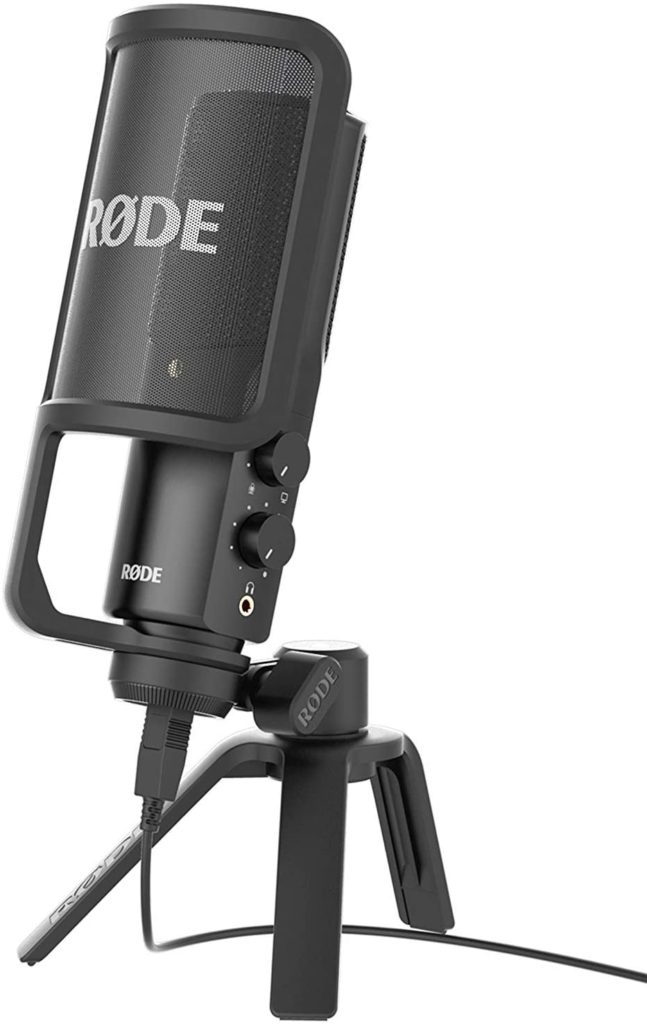
Another excellent microphone for recording podcasts is the Rode NT-USB. It delivers studio-quality sound in an all-in-one podcaster package. The built-in A/D converter is 16 Bit and 48kHz sampling rate. With this plug and play mic, all you need to do is connect it to your computer and start recording using any recording software.
The sound quality of the Rode NT-USB
One of the outstanding characteristics of this side-address microphone is the extreme detail in which it picks up the sound. The highs are very crisp and detailed, yet the frequency response is clear at mid and low frequencies, it doesn’t sound muddy at all. Your voice will be full, clear, and the mic will pick all the aspects in detail.
Besides, this mic will pick up the fundamental frequencies of vocals strongly relative to harmonics. In simple words, this means that it picks the low frequencies at an adequate level around 100 to 300Hz, making your voice sound fuller with excellent dynamics.
It has a 1/2″ electret condenser capsule that picks up every sound in detail. This could be an advantage or disadvantage, depending on your setup. If you don’t have a quiet room for recording, it could end up picking up all ambient noises, which could end up being a problem.
Features
- Studio-quality microphone with convenient USB connectivity.
- It comes bundled with everything you need to start recording right away. In the box, you’ll get a pop shield, tripod desk stand, ring mount, storage pouch, and 20’ (6m) USB cable included.
- The onboard audio interface allows for Zero-latency monitoring, and it’s done directly from the mic with the 3.5mm stereo headphone jack.
- On the side of the mic’s body, there are two knobs, one to control the volume of the headphone monitoring and one for adjusting the level mix between recorded audio and microphone input.
- Compatible with Mac OS, iPad, Windows.
Rode Procaster Dynamic Vocal Microphone
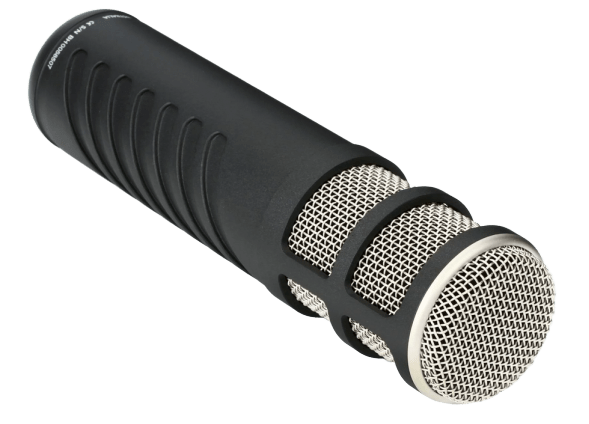
The Rode Procaster was specifically designed for broadcast and recording applications. This is one of the best microphones for podcasting because it’s dynamic capsule is tailored to deliver a precise voice frequency response.
Its balanced low output impedance makes it an ideal mic for podcasting, broadcast, and voice-over applications. Plus is has a superior ambient noise rejection so that your podcasts and recordings sound professional.
The sound quality of the Rode Procaster
The Procaster performs excellently for voice applications. It has a beautiful low end that is tight, delivering good low-frequency detail. The high-end frequencies have a presence, meaning that the reproduced sound gives you a sense of closeness and clarity, feeling like you are present in the room listening.
Besides, it has an excellent transient response and a good reproduction of voice dynamics. The high midrange audio frequencies between 2kHz and 6kHz are boosted by 4dB delivering a warm, mellow sound.
This microphone has a cardioid polar pattern, making it sensible in the front and less sensitive on the sides and back, perfect for podcast recording or live streaming.
Ruggedness
With the Procaster, you can be assured that the build quality is top-notch, like with any other Rode product. The mic is robust, with an all-metal construction body with a heavy-duty metal mesh to protect the capsule.
Internally, the capsule is isolated by an internal shock mount to minimize handling noise.
Features
- It delivers high-quality sound for podcasting or live broadcast environment.
- Low impedance output.
- Internal pop filter for a cleaner sound.
- It is tailored for voice frequency response.
- The frequency response is from 75Hz to 18kHz.
Electro-Voice RE20 Large Diaphragm Dynamic Vocal Microphone
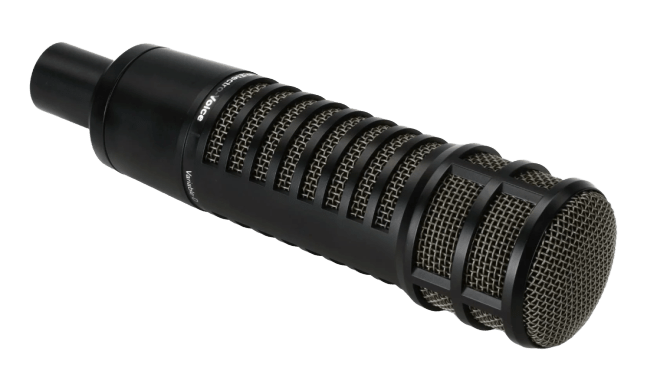
The RE20 from Electro-Voice has been the standard in the broadcast industry for decades, and that is due to its smooth and linear response characteristics on voice. These and many other reasons are what make the RE20 be one of the best microphones for podcasting used by many professionals around the world.
The Sound Quality of the Electro-Voice RE20
The RE20 performs excellent for voice applications such as podcasts or voice over. Its large Acoustalloy diaphragm and low-mass aluminum voice-coil produce a sound with a lot of clarity. The tone of your voice will be detailed, clear, and not opaque.
Spoken word applications require essentially a flat response over a very wide frequency range so that the voice is heard in its fullness. With the RE20, you get a wide flat frequency response, a sharp time response, and very low distortion. Plus, very low noise revealing all aspects in incredible detail.
Although this is a dynamic microphone, it’s easily comparable to the performance of condenser mics thanks to its crisp high-frequency response and balanced mids and lows. Its cardioid pick up pattern rejects noise from the sides and back, focusing primarily on your voice.
Ruggedness and Build Quality
This microphone is built to last thanks to its steel body construction and heavy-duty steel mesh to protect the capsule and electronics inside. Under the metal protecting mesh, there is a wind pop filter to cover all the acoustic openings.
The RE20 will continue to function flawlessly even in high humidity and elevated temperatures situations. Usually, these conditions would damage a condenser mic or a competitive dynamic mic, but this is not the case with the RE20, it is built to last.
Features
- Frequency Response: 45 Hz – 18,000 Hz
- Steel case and hum-bucking coil provide exceptional magnetic shielding.
- Cardioid polar pattern for better noise rejection.
Shure SM7B Cardioid Dynamic Microphone
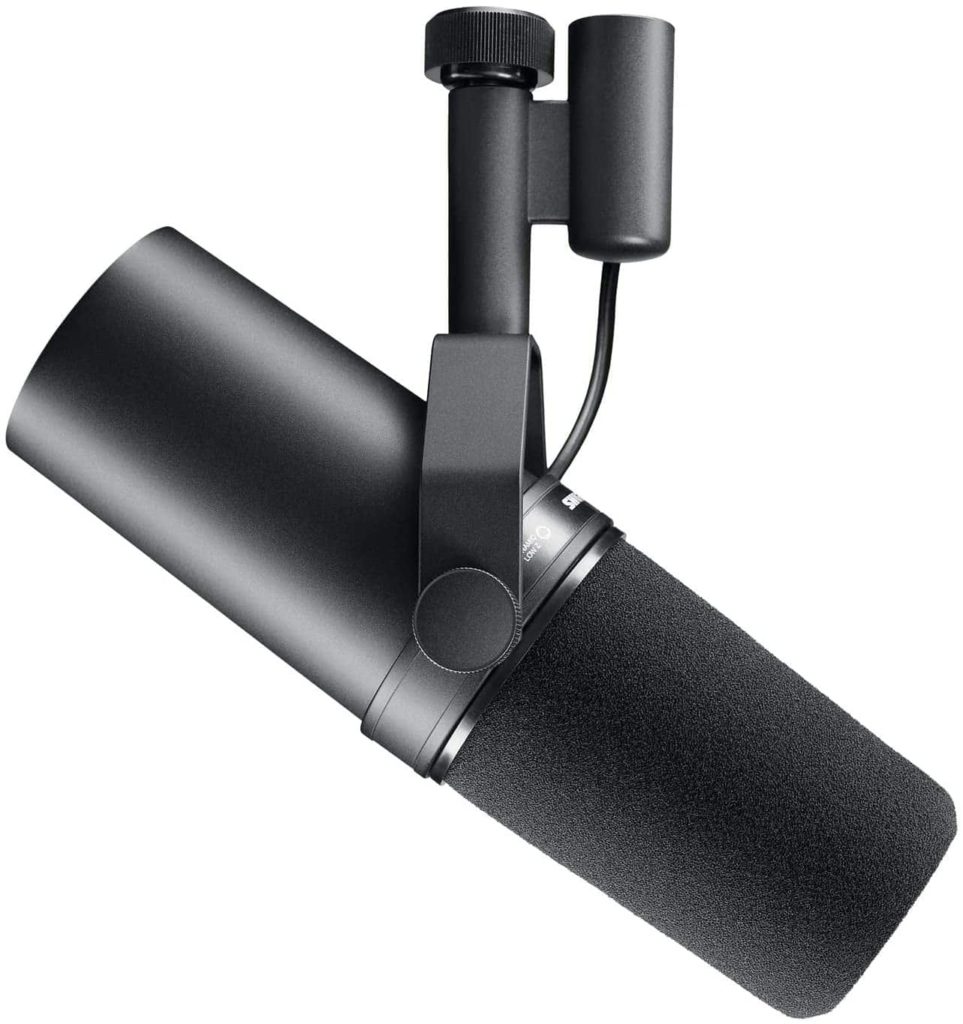
Finally, we present the most popular and absolutely the best microphone for podcasting, the Shure SM7B. No wonder this is the first and only choice for professional podcast and broadcast studios around the world.
With the SM7B, you will be able to capture smooth, warm vocals that preserve the naturality of the voice; that way, you can connect and transmit your message to your listeners.
The Sound Quality of the Shure SM7B
The Shure SM7B was explicitly designed for voice applications, and thanks to its flat, wide-range response, you will get exceptionally clean and natural reproduction of both speech and music. The captured sound is smooth, easy on the ears, and not harsh.
Moreover, the flat response in the midrange frequencies doesn’t have peaks or deeps, delivering beautiful, well-balanced tones. And with the warm, rich sound, and adequate low frequencies, your audience will enjoy the recorded voice, making your podcast sound professional.
Thanks to its cardioid pattern, the SM7B has a uniform capture, rejecting sound at the back and sides. That way, it captures the sound at the front in every detail.
Build Quality
Shure is a synonym of high quality and longevity. All of their microphones are designed to last for a long time, and the SM7B is not the exception. The body is made from aluminum, and the windscreen is made from steel, to protect the capsule and electronics inside.
It’s designed with an internal shock mount and vibration isolator to help maintain the capsule isolated. That way, handling and movement noises are significantly reduced. With this microphone, you will get outstanding quality and reliability.
Features
- Bass roll-off and mid-range emphasis (presence boost) control with graphic display of response setting.
- Improved rejection of electromagnetic hum, optimized for shielding against broadband interference emitted by computer monitors.
- The highly effective pop filter eliminates the need for any add-on protection against explosive breath sounds, even for close-up vocals or narration.
- It comes with the A7WS detachable windscreen, designed to reduce plosive sounds and gives a warmer tone for close-talk vocals.
- Yoke mounting with captive stand nut for easy mounting and dismounting provides precise control of microphone position.
Conclusion
In this article, we have presented the best microphones for podcasting. The first two choices are USB condenser mics perfect for beginners and solo podcasters on a tight budget. The last three options are professional-grade dynamic mics that deliver the best sound for your podcast.
Each options was chosen taking into consideration its frequency response, polar pattern, and the sound clarity it delivers for speech and voice. We hope this post helps you chose the right microphone for your podcasting project.